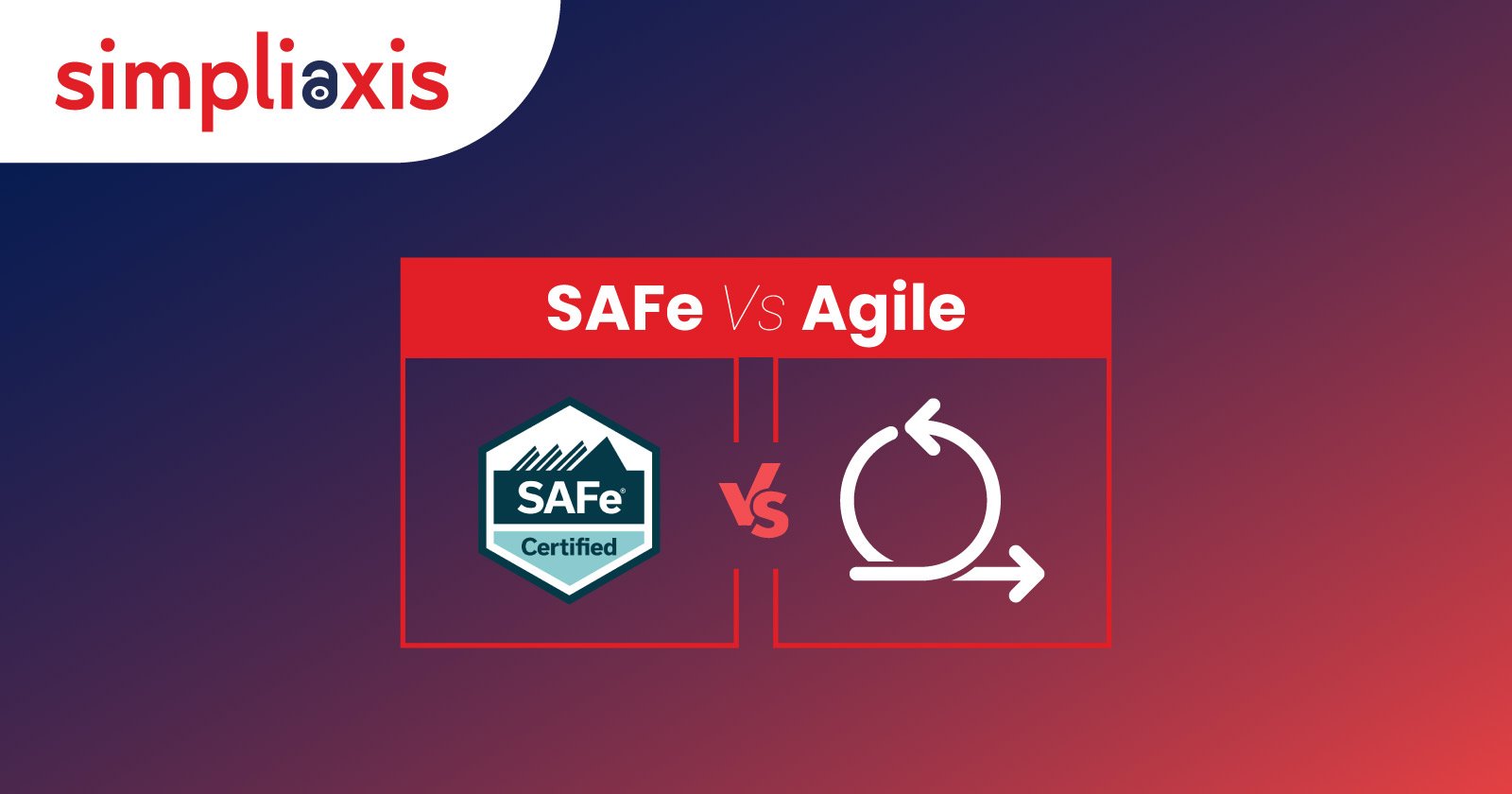Introduction :-
The Agile framework and Scaled Agile Framework (SAFe®️) operate under the umbrella of Agile values and principles. They are both used to develop high-quality products and services quickly, using iterative improvement methods. While both frameworks share the overarching goal of enhancing product development efficiency, they may differ in their operational methodologies and approaches. To decide which framework best suits your enterprise, it is crucial to have a comprehensive understanding of how Agile and SAFe work in practice
What is Agile?
Agile is an iterative and incremental approach toproject management in a dynamic environment. Agile processes are open to changing requirements and constant inputs and feedback from end-users.
1. Individuals and interactions over processes and tools:Interaction between people is critical in project management.
2. Working software over comprehensive documentation: Older project management approaches emphasized detailed documentation. The Agile approach realizes that getting to a successful result is more important than writing down the process.
3. Customer collaboration over contract negotiation: The customer’s involvement in the Agile approach is total. It is not limited to just drawing up a contract with terms and conditions.
4. Responding to change over following a plan: Agile approaches need strategies, but they are intended for change and flexibility, not rigidity.
There are many advantages to working on an Agile framework like Scrum. It is an excellent approach, especially for start-ups that have a few teams and work rapidly. Working on Agile frameworks increases job satisfaction because freedom and autonomy are valued.
Also, Check:What is Agile? What is Scrum?
What is SAFe (Scaled Agile Framework)?
The Scaled Agile Framework, developed in 2011, helps companies to work effectively and rapidly so that their products and services can reach the end-user quickly. SAFe uses Agile management elements, but the processes are improved to surmount the difficulties of large teams working on complex projects.
SAFe management follows a central set of principles to improve efficiency. These include:
- Taking an economic view of planning means everyday decision-making must be done within an economic context, considering the project’s budget.
- Assuming variability in projects: A single-pronged approach of design and development is not taken. Multiple requirements and design options are considered and then optimized for the best economic value.
- Decentralizing decision-making: When the people closest to the process make decisions, speedy process changes and a responsive feedback mechanism occur. Other strategic decisions have economic implications that require centralized decision-making. Both types of decision-making work in this framework, creating a fast and focused value chain.
SAFe helps larger organizations by allocating individual, independent teams to a productive sequence. It applies the Agile practices to the entire company, not just to one department at a time.
Here are some of the differences between Agile & SAFe Agile:
| Agile | SAFe Agile | |
| Framework | Agile frameworks are built on Agile principles | SAFe is a scaled-up framework of Agile principles |
| Role of management | Management plays only a supporting role in everyday functions. They are critical during the transition to Agile. | There are management roles. For example, Portfolio managers are responsible for the enterprise’s financial, technical, and business aspects. The Product Manager at the program level is responsible for prioritizing product features and ensuring they are well-understood. |
| Team Organisation | Agile teams have no sub-teams or hierarchies. They focus on completing small goals one at a time towards creating the end product. | SAFe frameworks have ART – Agile Release Trains, which are virtual organizations of Agile teams that plan and work together on the same timeline to achieve the Value Stream goals. |
| Decision making | Independent decision-making is encouraged. | Decisions can be made either at the team level or at the enterprise level, depending on the scope of the issue. |
| Planning | Planning is done not for the entire project but for shorter durations. The process is not complicated or long | Planning and the development cycle are long processes because of the focus on the ‘big picture.’ |
| Ability to change | Agile methods are planned around flexibility and change. Products can be improved after each iteration. | Making changes in a SAFe process is possible but not as easy to execute because of the large scale. |
| Role of team members | Agile relies on the commitment and expertise of individual team members to work with dedication. It is not always a practical expectation, and project deadlines may be missed due to some weak links in the team. | Since there are established leadership roles, large-scale projects can be completed with the development teams’ involvement and top management. |
| Alignment with business goals | Since this approach is more bottom-up, developers and testers focussed on their tasks can lose sight of business objectives. | The top-down alignment and management involvement in making strategic decisions ensure that business objectives are met. |
Advantages of Adopting SAFe Agile
The most significant advantage of using Agile SAFe is its ability to take the Agile framework (that is known to create efficient software development processes) and scaling it up by making the necessary changes at the enterprise level. Agile is extended beyond the development team’s scope towards enterprise leaders whose job is to think strategically with this method. It can handle large-scale projects with complicated issues while working more effectively than traditional methods. Because of the large scale of operations, managing team coordination is a huge task; SAFe methods organize the workflow so that multiple teams can work together with fewer impediments.
Problems of SAFe Agile
The advantage of the SAFe approach is management’s involvement for smooth operations and enterprise-level decision-making. Some teams find this a difficult way to work and prefer more autonomy. Not being involved in the project's value stream decisions means that frontline team members have a limited understanding of the project they are working on.
SAFe can limit flexibility and slow development and innovation because administrative layers oversee multiple teams and projects. These layers make SAFe advantageous for larger organizations.
Because the priority is given to large-scale business goals, the SAFe process involves long planning sessions and requires permanent roles within software development life cycles. Such a system is the antithesis of more modern practices where newer products are delivered to the markets, as per customer requirements. It is also challenging to act nimbly on feedback.
Advantages of Agile
In the Agile process, stakeholders—including customers and business leaders- have several opportunities to get involved in the production of the product. Because of the emphasis placed on communication and feedback, there is active collaboration and increased collaboration between developers and stakeholders.
As a concept, this is an excellent practice, but it requires mature people to execute it correctly. Otherwise, it can be seen as an exercise of putting excess pressure on the developers.
Since a large project is broken down into smaller units of work, it is possible to produce high-quality products with improvements in each cycle. However, this can also mean increased demands from stakeholders since no end product has been defined.
As with any methodology, there is no perfect choice about what an organization needs. Whether it is Agile or SAFe Agile, both the frameworks discussed above have several positives. They also have typical issues that cannot be ignored. Professionally trained and experienced practitioners and coaches can guide you on the options that could meet your organization’s requirements.
Conclusion:
In the dynamic landscape of project management, organizations often find themselves at the crossroads of choosing between Agile and Scaled Agile Framework (SAFe®️). While both frameworks aim to enhance product development efficiency, they operate on distinct principles and methodologies. Enroll at Simpliaxis for SAFe and Agile Courses as Simpliaxis offers comprehensive courses in SAFe and Agile methodologies, equipping professionals with the knowledge and skills to navigate complex project environments. By enrolling in our classes, individuals can gain insights into both frameworks and make informed decisions tailored to their organization's needs. Unlock the potential of your teams and propel your projects toward success with Simpliaxis. Enroll today!
















